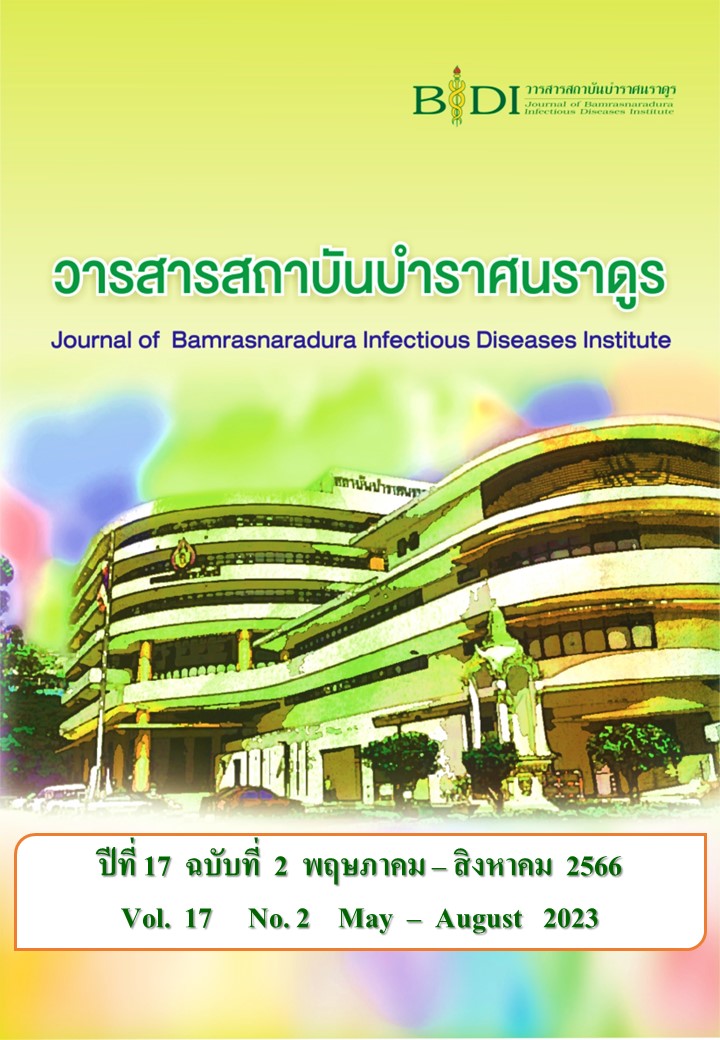ปัจจัยทำนายพฤติกรรมการดื่มเครื่องดื่มแอลกอฮอล์ ของอาสาสมัครสาธารณสุขประจำหมู่บ้าน
Main Article Content
บทคัดย่อ
การวิจัยเชิงพรรณนาเพื่อวิเคราะห์ความสัมพันธ์เชิงทำนายนี้ มีวัตถุประสงค์เพื่อศึกษาพฤติกรรมการดื่มเครื่องดื่มแอลกอฮอล์และปัจจัยทำนายพฤติกรรมการดื่มเครื่องดื่มแอลกอฮอล์ของอาสาสมัครสาธารณสุขประจำหมู่บ้าน กลุ่มตัวอย่างคัดเลือกโดยการสุ่มหลายขั้นตอน เป็นอาสาสมัครสาธารณสุขประจำหมู่บ้าน จำนวน 272 คน ในเขตพื้นที่อำเภอเต่างอย จังหวัดสกลนคร เก็บข้อมูลระหว่างเดือนมิถุนายน – กรกฎาคม พ.ศ. 2563 เครื่องมือที่ใช้ในการเก็บรวบรวมข้อมูลเป็นแบบสอบถาม ประกอบด้วย แบบสอบถามข้อมูลทั่วไป แบบสอบถามการรับรู้ ความสามารถของตนเองในการปฏิเสธการดื่มเครื่องดื่มแอลกอฮอล์ แบบสอบถามความคาดหวังในผลของแอลกอฮอล์เชิงบวก และแบบสอบถามพฤติกรรมการดื่มเครื่องดื่มแอลกอฮอล์ วิเคราะห์ข้อมูลโดยใช้สถิติพรรณนา และการวิเคราะห์ถดถอยพหุคูณแบบขั้นตอน
ผลการศึกษา พบว่า พฤติกรรมการดื่มเครื่องดื่มแอลกอฮอล์ของกลุ่มตัวอย่างส่วนใหญ่อยู่ในผู้ดื่มแบบเสี่ยงต่ำ (Mean = 4.82, SD = 7.044) ผลการวิเคราะห์ถดถอยพหุคูณ พบว่า การรับรู้ความสามารถของตนเองในการปฏิเสธการดื่มเครื่องดื่มแอลกอฮอล์เป็นตัวทำนายที่ดีที่สุด ( = -.573, p-value < .001) รองลงมาคือความคาดหวังในผลของแอลกอฮอล์เชิงบวก (
=.110, p-value = .029) โดยตัวแปรทั้งสองสามารถร่วมกันทำนายพฤติกรรมการดื่มเครื่องดื่มแอลกอฮอล์ของอาสาสมัครสาธารณสุขประจำหมู่บ้านได้ร้อยละ 37.1 (p-value < .001) จากผลการศึกษาครั้งนี้ให้ข้อเสนอแนะว่า บุคลากรที่เกี่ยวข้องกับการพัฒนาศักยภาพอาสาสมัครสาธารณสุขประจำหมู่บ้านควรพัฒนาโปรแกรมในการปรับเปลี่ยนพฤติกรรมการดื่มเครื่องดื่มแอลกอฮอล์ โดยการเสริมสร้างการรับรู้ความสามารถของตนเองในการปฏิเสธการดื่มเครื่องดื่มแอลกอฮอล์ และลดความคาดหวังในผลของแอลกอฮอล์เชิงบวก
Article Details
เอกสารอ้างอิง
World Health Organization (WHO). Global status report on alcohol and Health 2014. [Internet]. 2014. [Cited 2020 Mar 1]. Available from: https://apps.who.int/iris/bitstream/handle/10665/112736/9789240692763_eng.pdf
Center of Alcohol Studies. National Alcohol Policy Strategy. [Internet]. 2010. [Cited 2020 Mar 1]. Available from: https://main.samatcha.org/sites/default/files/22_112352_10_alcohol_main.pdf
Assanangkornchai S. Alcohol Consumption in Thai Society Report 2017.Bangkok: Sahamit Pattana Printing (1992) Company Limited; 2019.
Charoenbundith N. Factors Related to Health Promoting Behaviors Among Village Health Volunteers. [dissertation]. Chonburi: Burapha University; 2016.
Phonchai B. Alcohol Drinking Behavior among Village Health Volunteers in Municipality in Muang District, Nakhon Phanom Province. APHEIT Journal 2013; 19(2): 161 – 168. (in Thai)
Ponrachom C, Boonchuaythanasit K. The Intrapersonal Causal Factors of Alcohol Consumption Behavior of Undergraduate Students. Academic Journal Institute of Physical Education 2018; 10(2): 251 – 261. (in Thai)
Leigh, B.C., Stacy, A.W. Alcohol outcome expectancies: Scale construction and predictive utility in higher order confirmatory model. Psychological Assessment 1993; 5(2): 216 - 229. doi: 10.1037/1040-3590.5.2.216.
Young. R.M., Oei, T. Drinking expectancy profile : Test manual. Australia: Behavior Research and Therapy Centre; 1996.
Kijtorntham W. The Causal Relationship Model of Drinking Behavior and Consequences among Undergraduate Students in Thailand. Journal of Behavioral Science 2012; 18(2): 16 – 30. (in Thai)
Thanomsieng N. Sample_size_Multiple_Regression [Internet]. 2017 [Cited 2020 Mar 1]. Available from: https://home.kku.ac.th/nikom/sample_size_multiple_regression_2560.pdf
Young. R.M. Expectancies and drinking behavior: The measurement of alcohol expectancies and drinking refusal self efficacy, [dissertation]. Australia: University of Queenland, Brisbane; 1994.
Ponrachom C. The Causal Structural Relationship Model and Effectiveness of the Alcohol Drinking Behavior Modification Model on Undergraduate Students. [dissertation]. Bangkok: Kasetsart University; 2019.
Fromme K, Stroot EA, Kaplan D. Comprehensive effect of alcohol : Development and psychometric assessment of a new expectancy questionnaire. Psychological Assessment; 1993. 5: 19-26. doi. 10.1037/1040-3590.5.1.19.
World Health Organization (WHO). The alcohol use disorders identification test :AUDIT. [Internet]. 2001. [Cited 2020 Mar 1]. Available from: http://www3.who.int/whosis/alcohol/alcoholapedataprocess.efm
Department of Mental Health, editors. Proceedings of the 2 nd International Conference on Mental Health and Substance Dependence; 2003 Aug 19-21; Ambassador Hotel Bangkok. Nonthaburi: Department of Mental Health; 2003.
Department of Disease Control. Recommendations for Self-Protection [Internet]. 2019. [Cited 2020 May 21]. Available from: https://ddc.moph.go.th/viralpneumonia/file/introduction/introduction01.pdf
Hinkle, D.E., W. William, G.J. Stephen. Applied Statistics for the Behavior Sciences. 4th ed. New York: Houghton Mifflin; 1998.
Kong, G, Bergman, A. A motivational model of alcohol misuse in emerging adulthood. Addictive behaviors 2010; 35(10): 855-860. doi. 10.1016/j.addbeh.2010.06.005.


